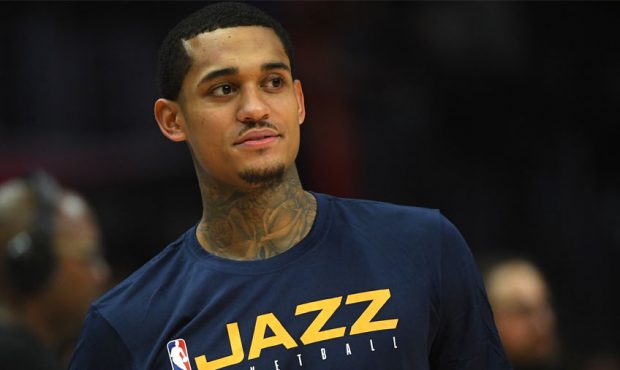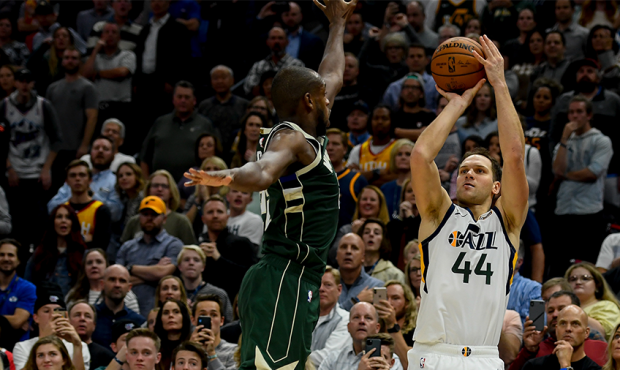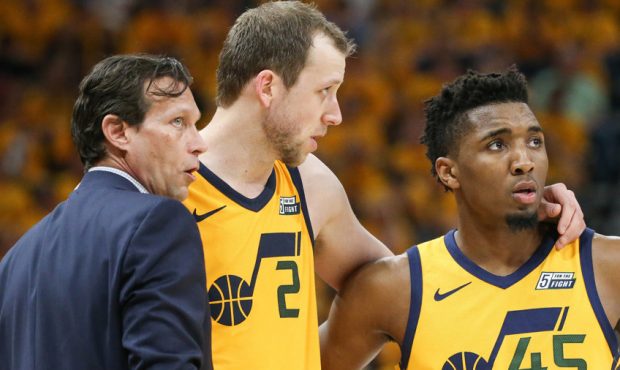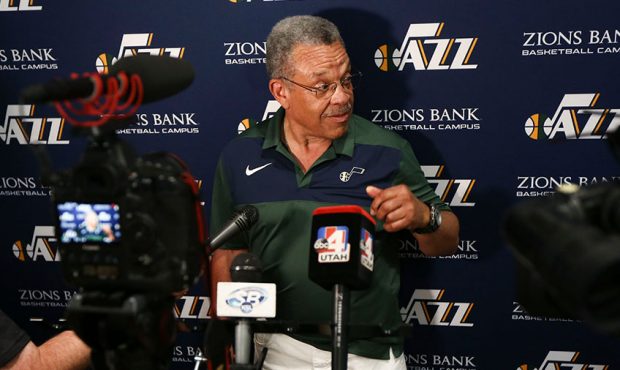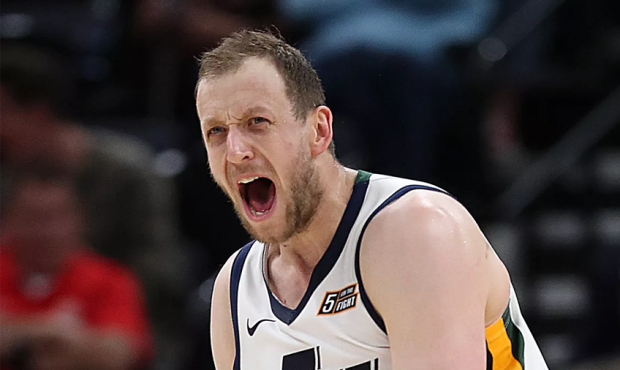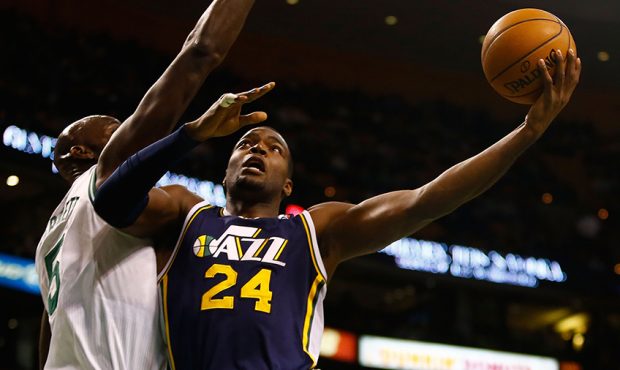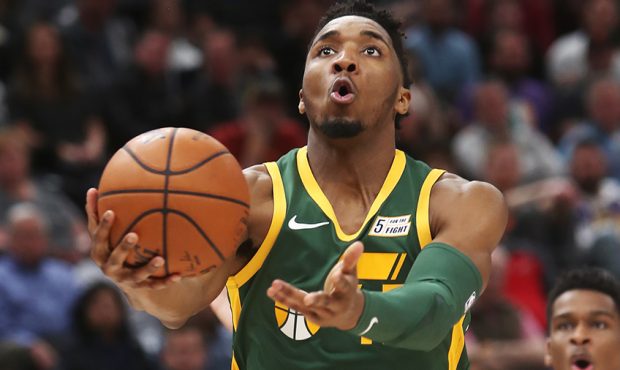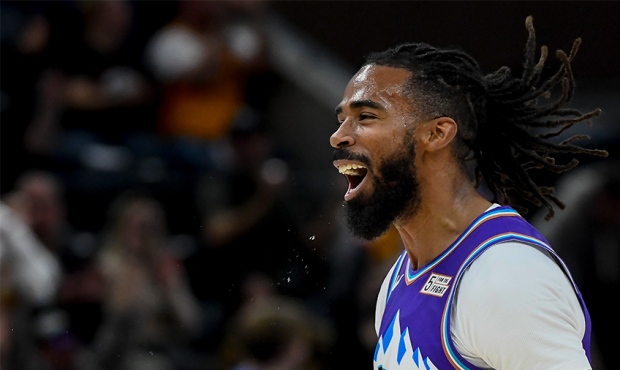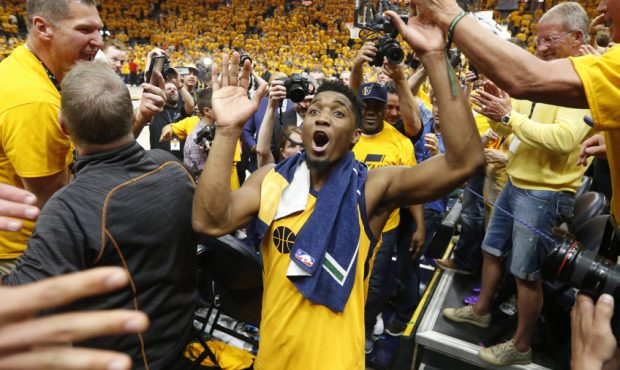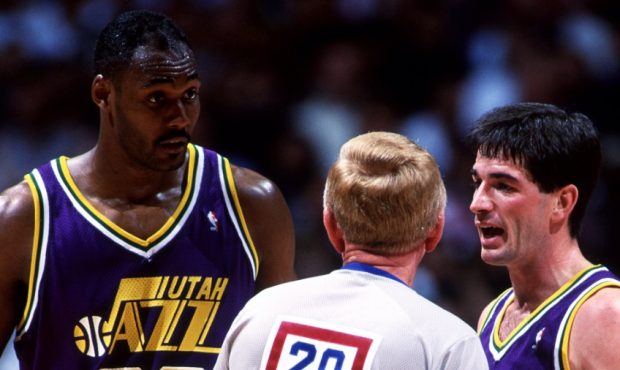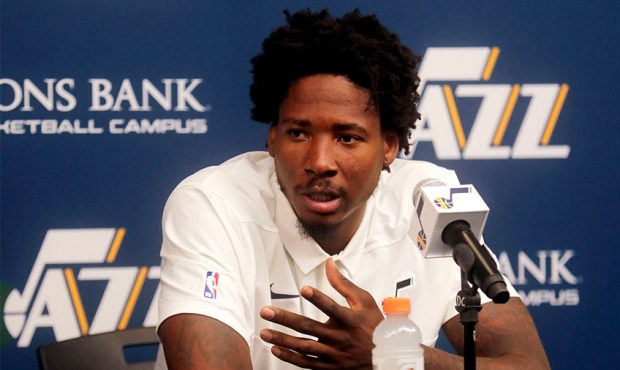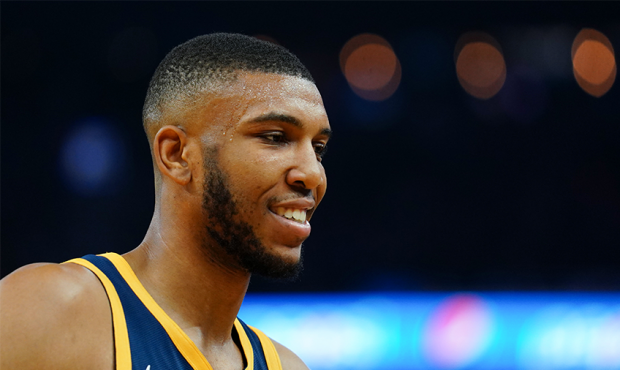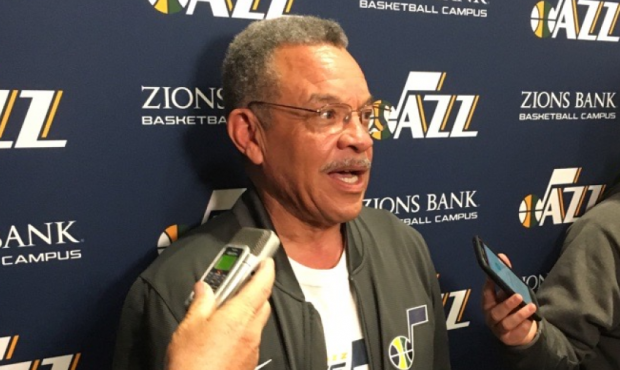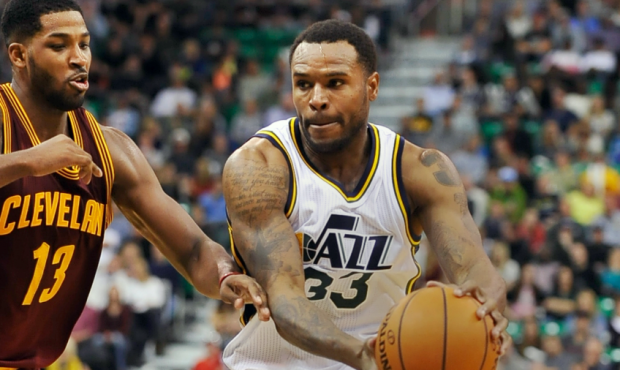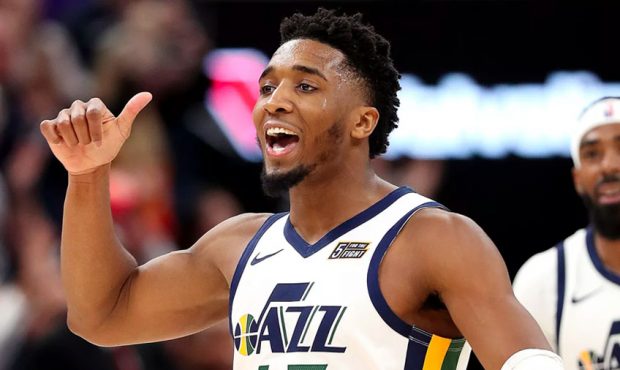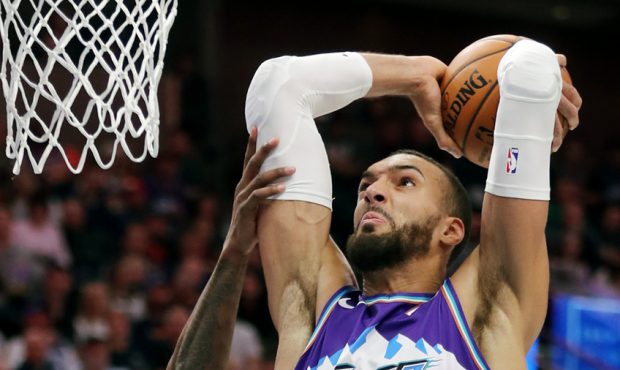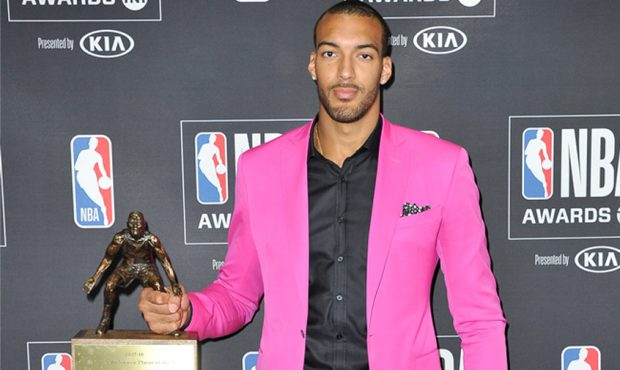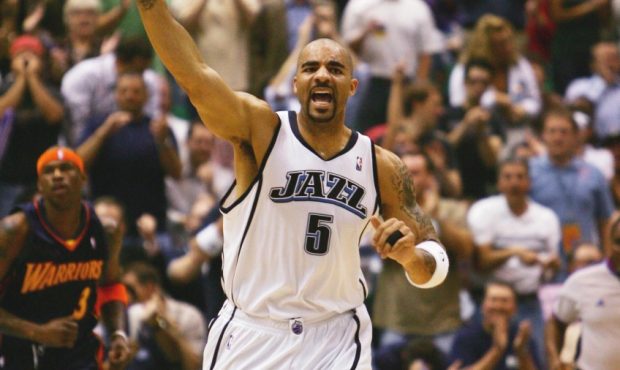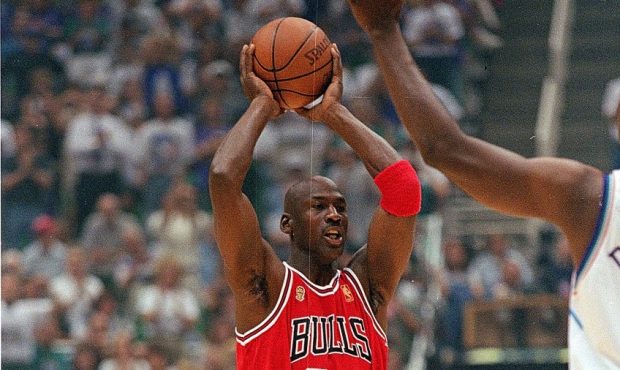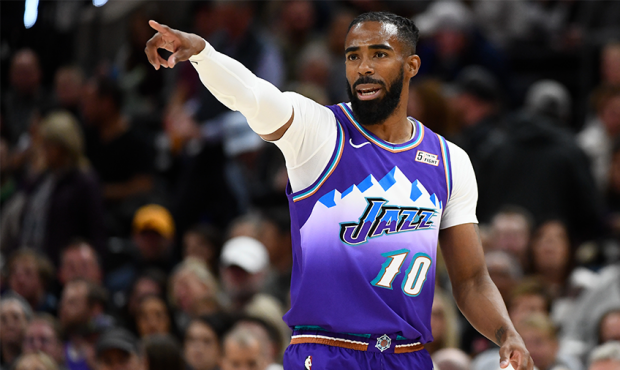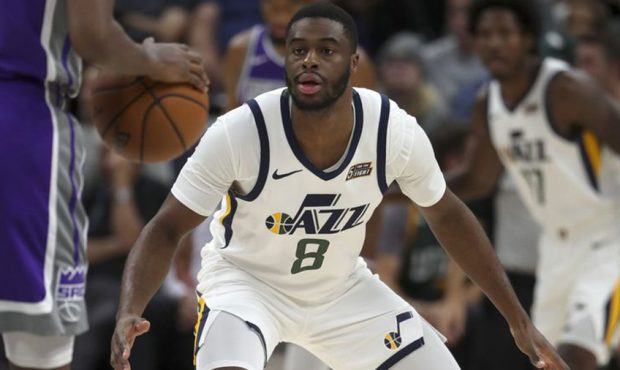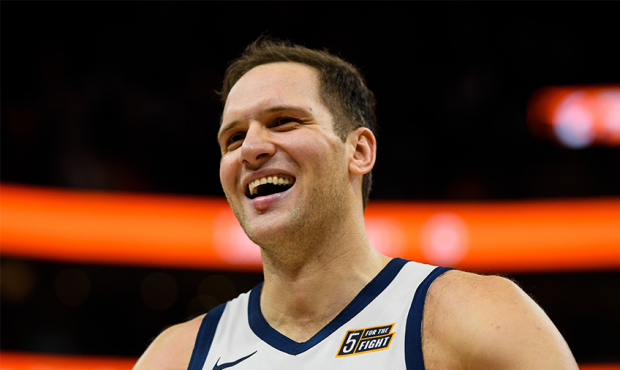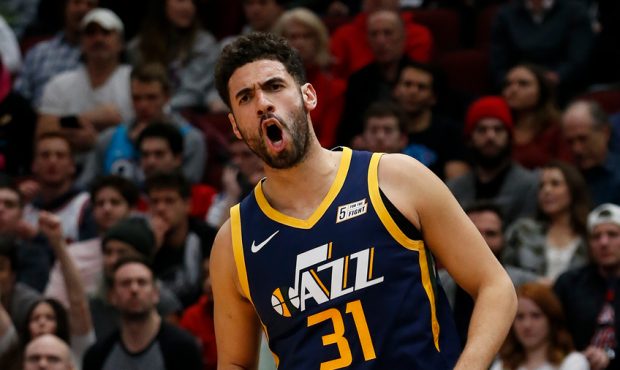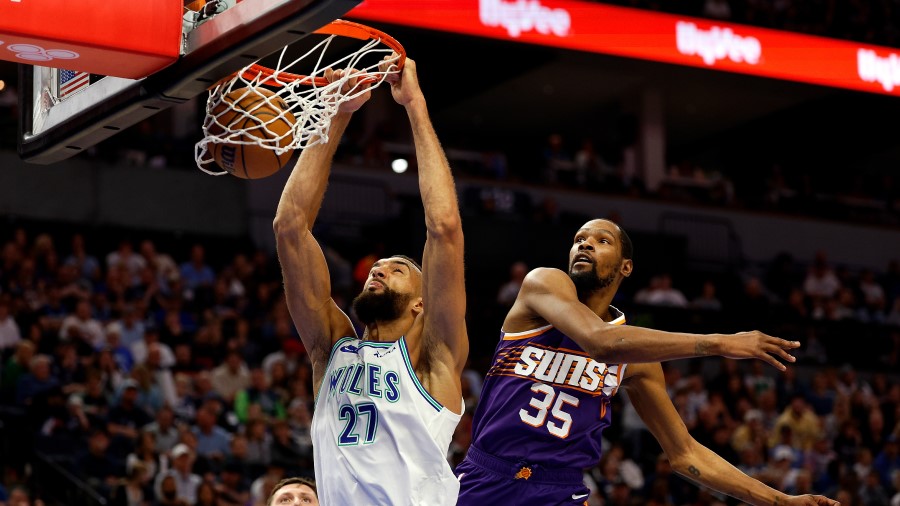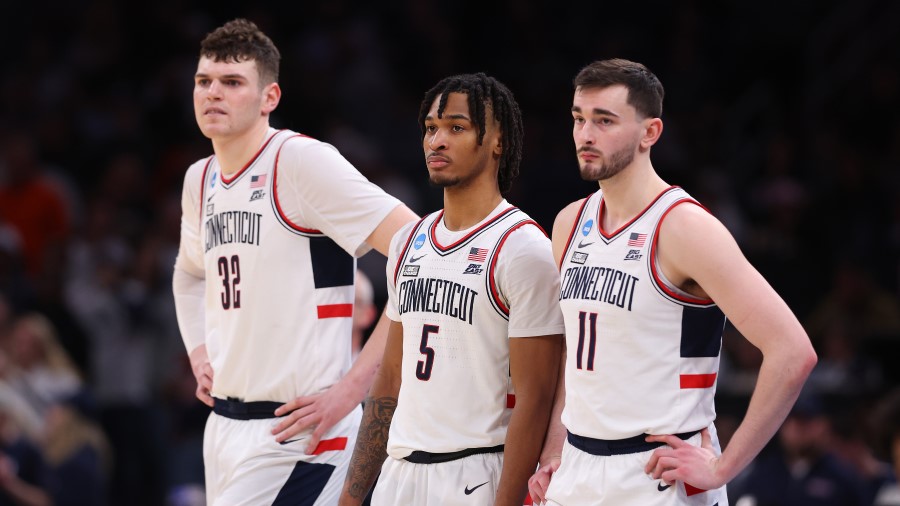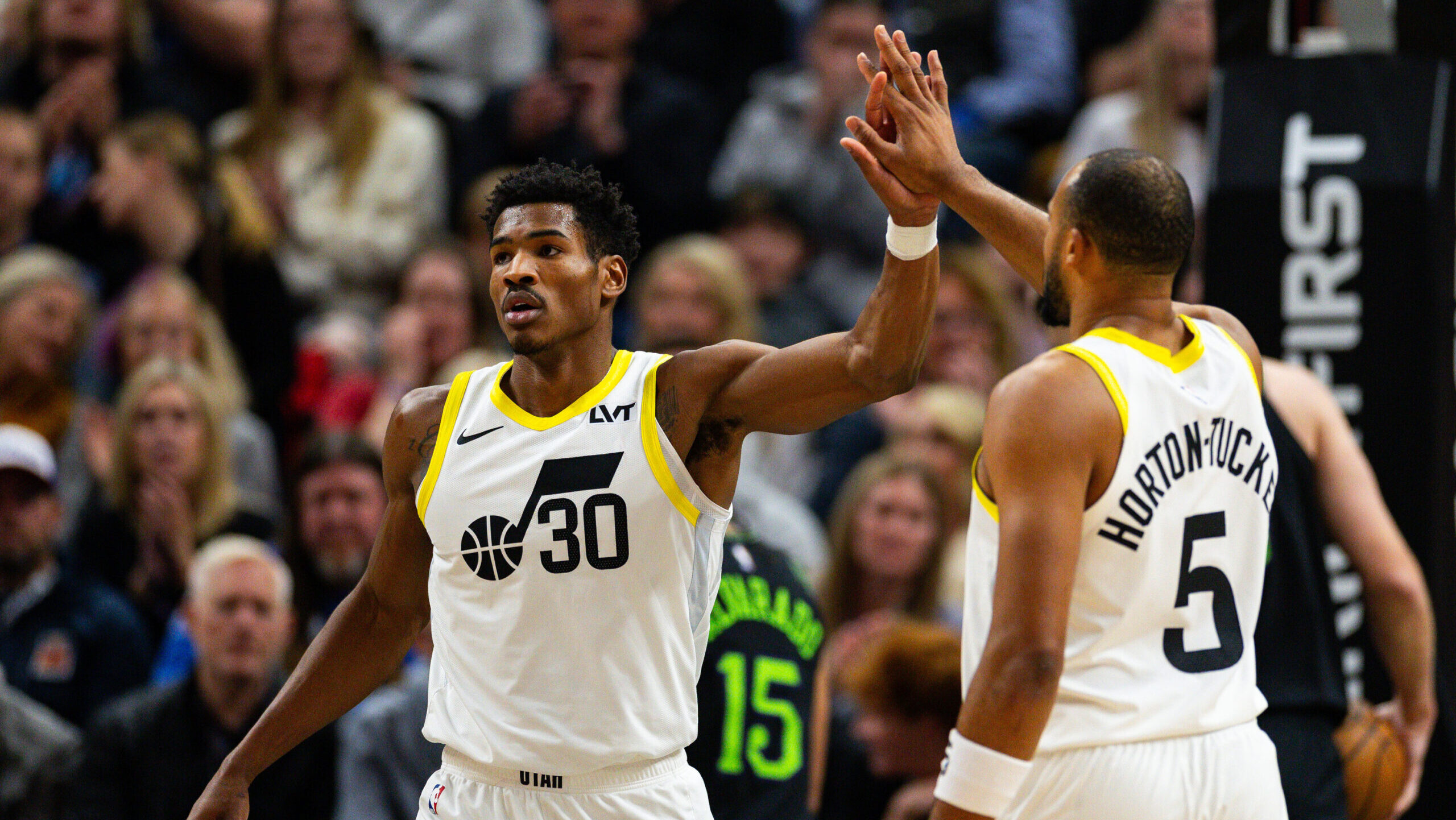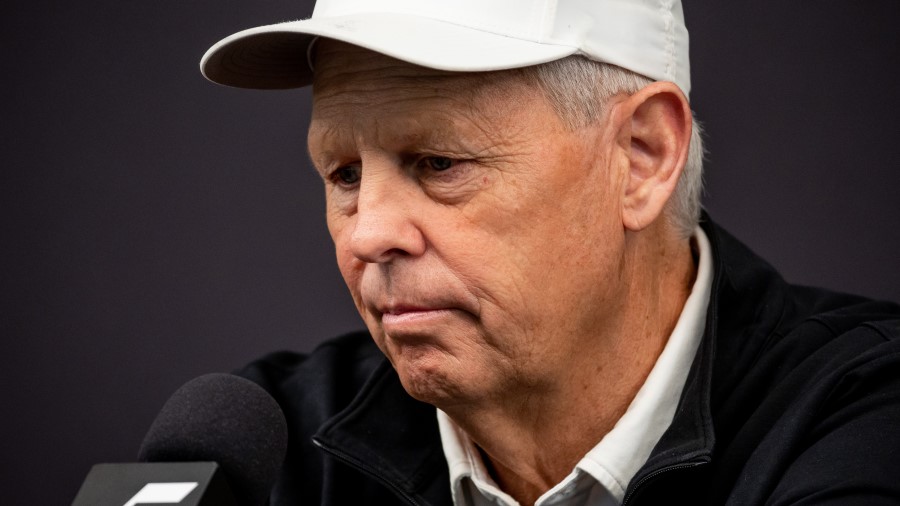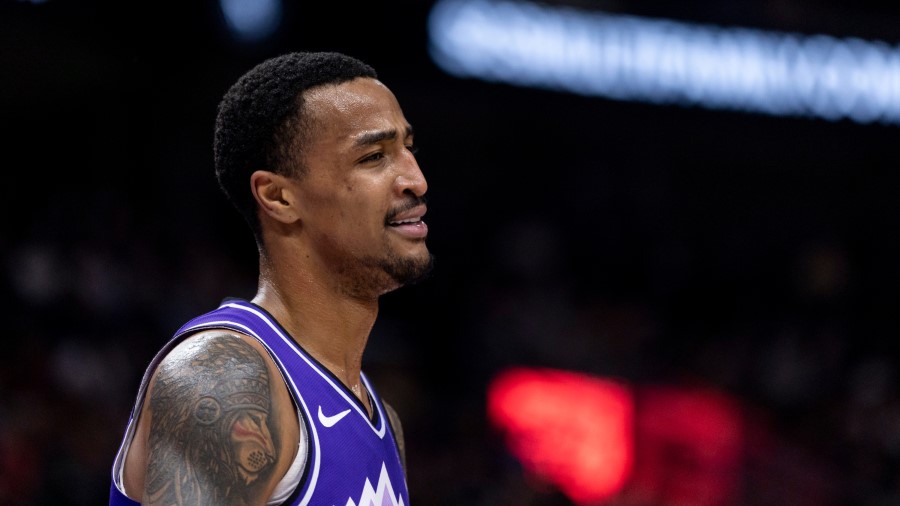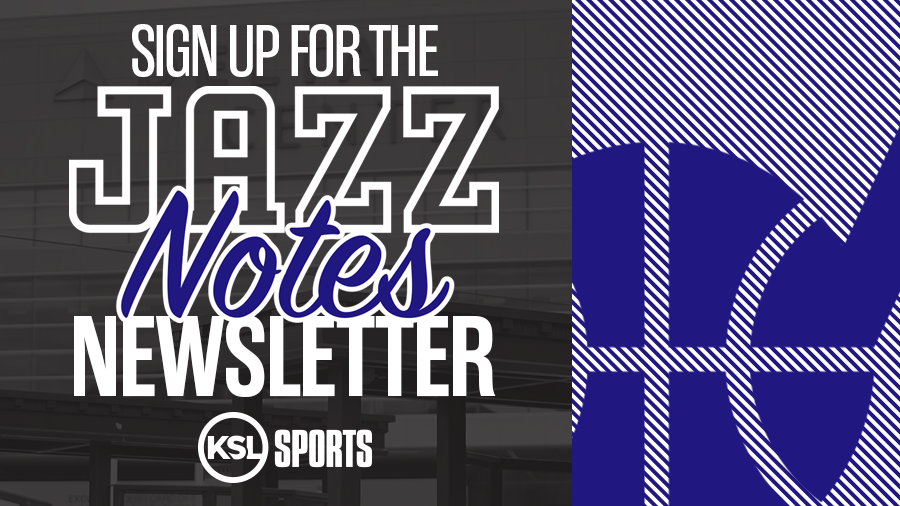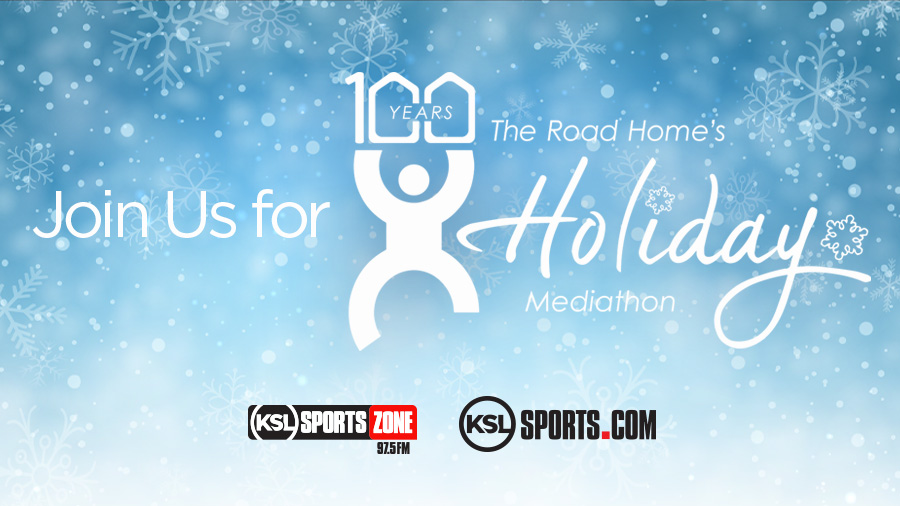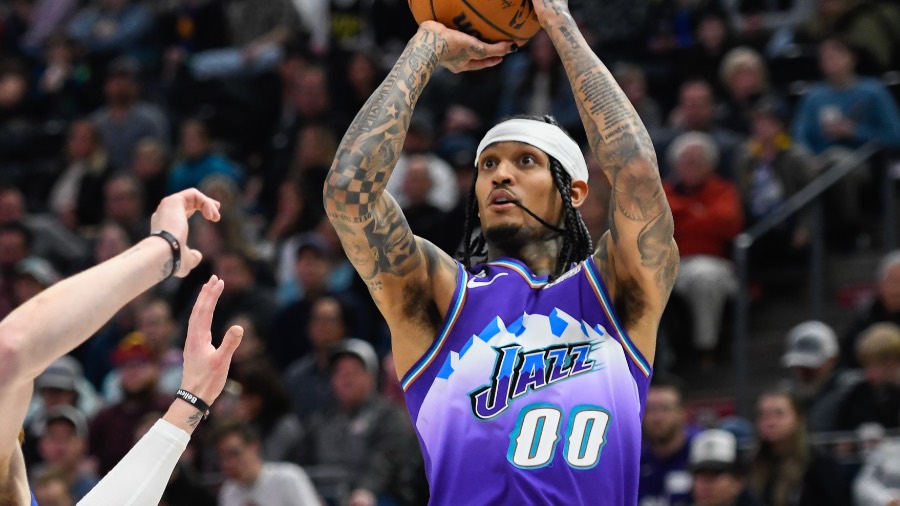The Complete 2019-20 Report Card For Each Utah Jazz Player
Apr 24, 2020, 4:04 PM | Updated: 4:06 pm
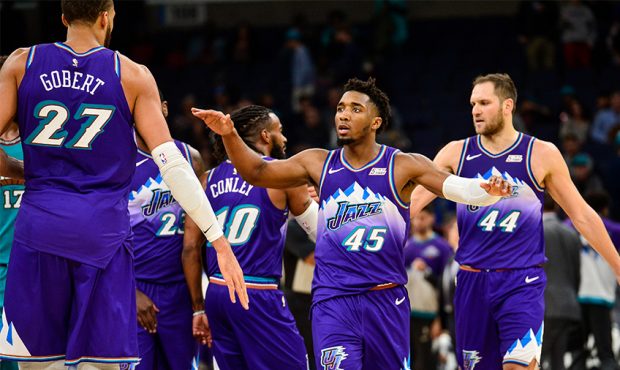
Donovan Mitchell #45 of the Utah Jazz greets teammates during the second half of a game against the Memphis Grizzlies at FedExForum on November 29, 2019 in Memphis, Tennessee. (Photo by Brandon Dill/Getty Images)
(Photo by Brandon Dill/Getty Images)
SALT LAKE CITY, Utah – The NBA is in a standstill as a result of the coronavirus outbreak that has sidelined professional sports across the globe. With 18 games left to play in the regular season for the Utah Jazz, and a date with the postseason on the line, it’s unclear when or if the season will return.
With game action in a holding pattern, it’s an ideal time to look at each player on the Jazz roster and how they have performed this season. Have they exceeded or failed to meet expectations, have they improved their game, remained steady, or seen a decrease in their level of play. Finally, how will they impact the team when games return, whether that’s to finish the 2019-20 season, or to begin the 2020-21 season.
This is the complete report card of every Jazz player.
Jordan Clarkson – 00 – Guard
Stats: 15.6 ppg, 2.9 rpg, 1.6 apg: .482/.366/.780
The Jazz acquired Jordan Clarkson on a December 23 trade with the Cleveland Cavaliers in exchange for guard Dante Exum. After seasons of waiting for the former fifth overall pick to develop into an impact payer, the Jazz cut bait with the Australian guard in favor of the previously mercurial Clarkson.
Clarkson had been a surprise breakout scorer with the Los Angeles Lakers during the first three and a half years of his career before being shipped to the LeBron James led Cavaliers for a future first-round draft pick.
With an expiring $13 million contract, the Cavs were looking to get an asset back for the potent bench scorer, while the Jazz were looking to find a way out from underneath the two years and $20 million left on Exum’s deal while adding an identity to the bench unit.
In short, Clarkson has quickly proved to be one of the best midseason acquisitions in Jazz history, especially considering the price the team paid to get him.
The sixth-year guard made his Jazz debut on December 26 and despite an inefficient scoring night, made his presence known as an isolation scorer capable of getting to the rim, finishing with a series of creative release points.
In just his second game with the team, Clarkson scored 19 points, matching the season-high of any Jazz reserve scorer to that date in a 120-107 victory in Los Angeles over the Clippers, the team’s best win of the season. In game three against the Detroit Pistons, Clarkson became the first Jazz bench player to score 20 points this season, a feat he’s accomplished 11 times this season, including two games scoring at least 30 points.
Since acquiring Clarkson, the Jazz have a record of 23-11, after an 18-12 start to the season, seeing a seven percent increase in win percentage since making the trade.
Based on Clarkson’s history as a high usage scorer on traditionally non-playoff teams, it was difficult to set a firm expectation of how Clarkson was going to perform for a team hoping to make a deep postseason run.
However, it’s safe to say the newest Jazz guard has easily exceeded expectations and has become one of the most important players in the team’s rotation.
Since joining the team, Clarkson’s 15.6 points per game average is the second-best of his career behind last season’s averages in Cleveland, meanwhile, his .584 true shooting percentage is the most efficient mark of his career.
Is this the best basketball of Jordan Clarkson’s career? pic.twitter.com/Yxj1LbbjMF
— KSL Sports (@kslsports) February 13, 2020
Though Clarkson’s head down scoring mentality has resulted in stretches of me-first basketball from the entire roster, his addition has been overwhelmingly positive. Clarkson still shows flashes of his point guard abilities delivering highly creative passes, and his effort on defense makes up for a lack of natural instincts.
Perhaps most surprising has been Clarkson’s fit within the team’s locker room. After beginning his career in Los Angeles, the one-time high profile guard seemed like a gamble fitting into Utah’s small-town culture. Instead, Clarkson’s laid back, ‘Good Vibe Tribe’ approach to the game on and off the floor has made him an ideal fit in the state.
Georges Niang is the latest @UtahJazz player to try his hand at podcasting.
In the debut episode, Niang sat down with newest Jazz guard Jordan Clarkson to discuss hiking in Utah, tattoos, and the #GoodVibeTribe. https://t.co/aZAHyxlhUP
— KSL Sports (@kslsports) March 31, 2020
The biggest question surrounding Clarkson’s time in Utah is whether the guard has already played his final game in a Jazz uniform.
If the season is heading for a cancellation, Clarkson is set to become an unrestricted free agent this summer in a weakened free agency class, especially at the scoring guard position. With a revamped image on a winning team, Clarkson could see his stock rise in the eye of teams looking to add an instant scoring punch to their rotation.
Strangely, the coronavirus outbreak may give the Jazz a leg up in resigning the guard. With a significant loss in Basketball Related Income, the NBA’s salary cap is due to drop next season from expectations. With a lower salary cap, there will be fewer teams spending money this summer, meaning a player like Clarkson may not see the bidding war for his services he could have otherwise expected.
The Jazz own Clarkson’s Bird Rights, allowing the team to go over the salary cap to resign the guard if required this summer. With Clarkson’s high level of play and natural fit with the roster, it seems he’d be the top target for the Jazz to retain this offseason.
In an up and down season for the Jazz, Clarkson has been an overwhelming bright spot that has provided the Jazz a release valve for an offense that highly reliant on three-point shooting.
📂 NBA
└📁 Utah Jazz players
└📁 Jordan Clarkson
└📁 Giving up on a play
└⚠️ File Not Found pic.twitter.com/7JsdMjbheQ— utahjazz (@utahjazz) February 25, 2020
Though far from a perfect player, Clarkson has played a significant role with the team as a scorer while bringing contagious energy to a bench unit that was floundering through the first two months of the season. To receive a player of his quality while also managing to get out from underneath the bloated contract of Exum while only adding future second-round picks to the trade continues to show the savviness and recognition of talent around the NBA from the team’s front office.
If the Jazz are unable to resign Clarkson this summer, they still received good value by saving money on the final year of Exum’s deal, though bringing him back at a similar price tag to his current deal, he could be a crucial piece in the team’s long term future.
Jordan Clarkson Letter Grade: A-
Joe Ingles – 2 – Guard
Stats: 9.8 ppg, 4 rpg, 5.2 apg: .441/.397/774
Perhaps no player on the Jazz roster has faced more adversity on the floor this season than Joe Ingles who has shifted between a role as a sixth man, to starting point guard, and back to the bench over the first 64 games of the season.
However, despite his everchanging role, Ingles numbers are remarkably consistent from last season. Despite a drop in points per game from 12.1 last year to 9.8 this season, a look at his assist, rebounding, and shooting numbers show incredible similarities from last year.
In 2019, Ingles averaged four rebounds, identical to his per-game average this season, while dishing out 5.7 assists, slightly above his 5.2 average through 64 games this year. Ingles .566 effective field goal percentage is up 1/1000th from his .565 average in last season.
Joe with our last 8 points 🇦🇺 pic.twitter.com/alITi4wOk8
— utahjazz (@utahjazz) March 10, 2020
In that sense, it’s hard to be critical of Ingles play this season. While that may be fair when examining his season from 30,000 feet, a more nuanced look reveals a wildly inconsistent season from Ingles.
Unsurprisingly, Ingles production is driven largely by his role, fluctuating between excellent play as a starter and inconsistent performances as a bench player.
Ingles began the season as the team’s sixth man, tasked with organizing a group of new-comers in Emmanuel Mudiay, Jeff Green, and Ed Davis to run Quin Snyder’s offense.
Unfortunately for the guard in his sixth year, the experiment was largely a failure to begin the season. Ingles production dipped dramatically from last season, seeing his averages drop to 7.3 ppg, 4.3 rpg, 3.5 apg while shooting just 36 percent from the floor and 31 percent from three.
Joe Ingles scored just 4 points on 6 attempts and committed 5 turnovers, including 3 live-ball. For the year, he's under 50% true shooting on low (14%) usage. He's obviously not the sole reason for Utah's struggles, but it's hard to compete with such production over 600 minutes. pic.twitter.com/auTDU9gbFA
— Positive Residual (@presidual) December 5, 2019
Meanwhile, the Jazz bench was regularly being outperformed whenever the team’s starters moved to the bench.
After an injury to starting point guard Mike Conley sidelined the veteran, Ingles was moved into the starting lineup and saw a radical uptick in his play.
Over the next 36 games as a starter, Ingles averages climbed to 11.4 points, 3.8 rebounds, and 6.1 assists, while shooting 46 percent from the floor and 43 percent from three. The Jazz went 24-12 with Ingles in the starting lineup, including winning 20 of the first 24 games after the move.
JOE INGLES IS ON FIRE
He's got 14 points in the first 6:30 of the game. He's 5/5 from the floor and 4/4 from three. #TakeNotepic.twitter.com/Yqt35cSSQY
— KSL Sports (@kslsports) December 27, 2019
After moving back to the bench in favor of a healthy Conley, Ingles saw a stabilization of his averages. Though his points per game once again dipped to just 8.3, his assist average stayed at a healthy 5.1 per game, while his rebounding average hovered at 4.4. Most importantly, Ingles shooting percentages didn’t see a dramatic drop, with his shooting percentage skyrocketing to 58 percent, and his three-point shooting percentage climbing to 44 percent.
It’s fair to say at this point in the season Ingles has seen neither a dip in his play nor a dramatic increase, though a lack of consistency from the versatile guard has plagued the Jazz during their tougher stretches.
For the Jazz to perform at their highest level, Ingles playmaking and shooting will have to be on point, and that’s been a gamble for the Jazz throughout long stretches this year.
The last seven games of the season before the league was sidelined were a promising development for Ingles future as a reserve, but most importantly the Jazz 5-2 record over the stretch indicates that Snyder may have found finally found a winning rotation with both Conley and Ingles in the lineup.
As has seemed to be the case for the organization (see Royce O’Neale), before moving Ingles to the bench, the team agreed to a one-year extension to the Australian guard’s existing contract that will keep him in Utah through 2022 at an average of roughly $12 million per season.
For a player of Ingles caliber, $12 million per season should be a bargain for the next two seasons as long as the veteran in his seventh and eighth seasons doesn’t see a dramatic drop in his play due to his declining athleticism.
"I'm too quick, obviously." —Joe Ingles#FilmRoom pic.twitter.com/uP9ABSgpbD
— utahjazz (@utahjazz) March 6, 2020
Ingles will be 33 going into next season regardless of when the league returns, so a decrease in speed and quickness is on the horizon. However, Ingles game is predominantly predicated on his unique timing, and knowledge of spacing and angles to be effective offensively, none of which should suffer from his athletic decline.
The guard continues to be instrumental for the Jazz as one of the team’s best shooters, and the player with perhaps the best feel for Snyder’s offense. Despite a rough start to the season after his move to the bench, Ingles seems to have stabilized his play and should be a key element in the franchise’s equation over the next few seasons.
Joe Ingles Letter Grade: B-
Mike Conley – 10 – Point Guard
Stats: 13.8 ppg, 3.2 apg, 4.3 apg: .405/.376/.795
There might be no player in team history that put on a Jazz uniform under a bigger microscope than Mike Conley did when the Jazz acquired him just before draft night in 2019.
The anticipation for Conley was so great that even the franchise kept the first images of the point guard in a Jazz uniform private until they announced the return of the purple mountain jerseys in late August.
You have your foundation.
You add new pieces.
Then you work.» https://t.co/i00OA0BAaS pic.twitter.com/DsYK5gTBNN
— utahjazz (@utahjazz) August 28, 2019
With Conley’s long successful history in Memphis and the Jazz needing a point guard who could take over games in the postseason, the hype surrounding the team’s acquisition was appropriate.
Unfortunately for Conley, the bar was set so high for success that it was going to be nearly impossible for the 13-year veteran to satisfy the anticipation.
Early on, Conley badly struggled with his shot in a Jazz uniform, causing an undue amount of handwringing amongst fans.
Through the first four games of the season, Conley connected on just nine of 45 shot attempts, including a 1-16 performance against Oklahoma City to open the season and an 0-7 performance against the Phoenix Suns resulting in just one point in 20 minutes of action.
Mike Conley broke out of his shooting slump & scored 18 of his 29 PTS (11-17 FG) in the 3rd quarter of the Jazz win over the Clippers!
Last 4 games
0-7 FG
5-11 FG
3-11 FG
1-16 FGpic.twitter.com/nMSgUmbW0Y— Ballislife.com (@Ballislife) October 31, 2019
Though Conley would see his shooting numbers improve over the next 17 games, the team itself struggled to open the season. With a record of 12-9 through 21 games, Jazz fans were left seeking the source for the team’s slow start to the year. After 50 wins a season ago, and the team’s other offseason acquisition, Bojan Bogdanovic filling up the box score, Conley became an easy target for disdain.
To make matters worse, Conley suffered a hamstring injury that would sideline him for 19 of the next 20 games. In the point guard’s absence, the Jazz would win 15 of their 19 contests, further muddying the view of Conley’s role with the Jazz.
In 19 games since returning from injury, Conley’s play has significantly improved, though the team has once again been plagued by inconsistency as coach Quin Snyder has worked to solidify his rotations
Since being moved back into the starting lineup, the Jazz are just 7-6 over their last 13 games, though Conley has seen his numbers improve dramatically. In the midst of this return to the starting lineup, reports emerged that Conley was going to be sent to the Jazz bench in favor of Royce O’Neale who had been displaced upon the point guard’s return, a decision that was quickly, albeit confusingly reversed the same afternoon it was rumored.
Despite the shaky ground in which Conley has found himself, the guard is averaging 16.5 points, 4.9 assists, and 3.8 rebounds, while shooting 46 percent from the field and an impressive 44 percent from the three-point line.
While the process of bringing Conley onto the roster seems to have consisted of one trade-off after another, it’s clear the 32-year-old still has plenty to offer a team looking to make the jump from a solid playoff team to a true contender.
craft·y
/ˈkraftē/eg. mike conley's layup shown here pic.twitter.com/4ssF7tGRkG
— utahjazz (@utahjazz) February 8, 2020
As Conley has proven since returning the starting lineup, he’s a reliable shooter and scorer, when the team’s other leaders are struggling, he’s got the ability to take over games on the road and will the Jazz to victory.
Whether the season returns this year or next, Conley appears to have found a new comfort level within Snyder’s system that will help push the team to the next level.
Perhaps one darkhorse issue that could be facing the Jazz is the status of Conley’s contract next season. The point guard has a player option for $34 million next season, a number that seems impossibly high to pass up.
Mike Conley hasn't just been the best scorer on the floor he's been the smartest player on the floor.
Constantly in the Celtics passing lanes, knows exactly how to counter Boston's defense.
Impressive point guard play, by far the best of the season.
— Ben Anderson (@BensHoops) March 7, 2020
However, should the guard decide his fit in Utah is not what’s best as he enters the twilight of his career, could Conley look to find a new franchise to join while signing a longer contract mitigating some of the money lost from last season?
With a salary cap that will inevitably drop as a result of basketball-related income due to the coronavirus pandemic, it would be difficult for Conley to find such a massive contract, but in a talent depleted free agency class, the veteran guard would undoubtedly have suitors.
The Jazz should plan on Conley return next season, and as he’s shown at his best, could still factor into the team’s long term plans, even beyond the final year of his current contract.
However, for Jazz fans to grant a passing grade to the team for the point guard’s acquisition, blending Conley’s improving stats and the team’s performance will be a top priority.
Mike Conley’s Letter Grade: C+
Tony Bradley – 13 – Center
Stats: 4.7 ppg, 4.3 rpg, 0.3 apg: .665/1.00/.650
Tony Bradley was likely facing a make or break season entering the year for the Jazz. The former 28th overall pick in the 2017 NBA draft had played a total of 12 games in his first two seasons with the franchise and entered the year buried in the depth chart once again.
After losing Derrick Favors over the summer, the Jazz signed center Ed Davis who seemed like the ideal back up center for Rudy Gobert in the team’s second unit.
However, the Jazz bench unit struggled despite a series of shakeups and Davis never quite found a role in the team’s offense that relied more heavily on a big man that could roll to the hoop.
I'm blown away by the progress Tony Bradley is making. 7 points, making free throws, defending well, offensive rebounds and nice passes in this game. Ran the floor, caught the pass and finished in traffic. pic.twitter.com/Fp0JXRYnWt
— Jeremiah Jensen (@JJSportsBeat) January 7, 2020
After suffering a leg fracture six games into the season, Bradley was forced into the rotation and showed the value of a big man who can catch the ball and finish near the rim in Quin Snyder’s system.
Davis retook the backup job after a 12 game absence but once again struggled to fit in with the bench. Bradley overtook Davis in late December as the Jazz shook up their lineup trading for guard Jordan Clarkson and waiving forward Jeff Green and hasn’t looked back.
Tony Bradley for 3? TONY BRADLEY FOR 3!!!! #TakeNote #UtahJazz #NBA #NBATwitter pic.twitter.com/P9gGNdqo4r
— Jeremiah Jensen (@JJSportsBeat) February 29, 2020
Bradley is far from a perfect player but has proven his value as an NBA player with a knack for rebounding and frame that is tough to contain when rolling to the hoop.
The third-year center has surprisingly good hands that help both as a rebounder and catching tough passes which has made him an ideal pick and roll partner with Joe Ingles and the Jazz second unit.
Seems like one of the big changes with Tony Bradley lately has been his confidence.
He seemed to be trying so hard to not do anything wrong earlier this year, now he looks like he's just playing and it's helping the Jazz.
— Ben Anderson (@BensHoops) January 21, 2020
At times, Bradley’s inexperience is still apparent on the floor, regularly leaving his feet to contest jump shots which can lead to foul trouble when a standing shot contest would suffice. His lack of speed causes him to struggle against the smaller lineups that are becoming more common around the league. However, that’s a minor complaint considering the number of good things he’s shown on the floor.
Bradley has been one of the team’s most unexpected bright spots this season and is a testament to the Jazz organization’s patience and player development abilities. Though Bradley lacks the physical gifts to be a starting center in the NBA, he should continue to play a solid role off the bench as he continues to add to his game.
While it seemed like a gamble for the Jazz to pick up Bradley’s qualifying offer for the 2020-21 season before the year began, that looks like a wise move for a player that will likely enter next season penciled as the team’s back up for Gobert.
Furthermore, Bradley’s consistency should allow the Jazz to move Davis in hopes of returning an asset that is more likely to help the team this offseason.
Tony Bradley’s Letter Grade: B
Ed Davis – 17 – Center
Stats: 1.3 ppg, 3.8 rpg, 0.3 apg: .412/.455
Inarguably, Ed Davis has had the most disappointing season of any Jazz player based on expectations this year. Davis was signed to replace Derrick Favors as the team’s reserve center, a role in which he’d excelled with several teams during his nine-year NBA career.
Zion vs. Ed Davis pic.twitter.com/FEKpRYLY3B
— Dime (@DimeUPROXX) October 12, 2019
However, Davis’ game hasn’t clicked with what coach Quin Snyder has asked of him, and he’s since lost his rotation minutes to third-year center Tony Bradley.
Davis is averaging career lows in every major statistical category save steals per game, while having the most inefficient shooting season of his career. It’s been a bizarrely steep drop off from a player who has contributed to his former teams as a rebounder and hustle player, skills that traditionally translate wherever a player suits up.
Davis’ per minute averages have also dipped considerably in just one off-season, ranging from perhaps the best season of his career last year in Brooklyn to his nearly untenable play in Utah.
A large part of Davis’ dip in production is due to his poor fit within Snyder’s offense. With Joe Ingles running the offense off the bench before Jordan Clarkson joined the roster, the team was heavily reliant on Ingles ability to initiate the pick and roll.
Davis, however, is not a pick and roll player. The majority of the center’s scoring has traditionally come from putback scoring opportunities and hustle plays. The veteran in his 10th year lacks the size, hands, and finishing ability to excel predominantly as a rolling big man.
Until the team acquired Clarkson in late December, the entire bench unit struggled to compete with opposing second units. Between Ingles, Davis, Emmanuel Mudiay, Dante Exum, and Jeff Green, the Jazz bench featured a group that lacked any discernible identity.
Utah Jazz center Ed Davis has a fractured left fibula. The injury occurred against Sacramento. He will be reevaluated in 4 weeks.
— Jeremiah Jensen (@JJSportsBeat) November 2, 2019
To make matters worse, Davis suffered a fractured fibula in the sixth game of the season, causing him to miss 12 of the first 18 games of the season. In Davis’ absence, Bradley showed an ability to improve from game to game, while providing the team a release valve as a rim roller in the second unit.
Upon Davis’ return, the center continued to struggle with the second unit and was replaced in the rotation just one game after the team traded for Clarkson and waived Green.
Perhaps the redeeming factor in Davis’ season has been the professionalism he’s shown since being pulled from the lineup. The former North Carolina product hasn’t made any public statements regarding any unhappiness about his current role, nor did he request a trade before the NBA’s trade deadline.
Additionally, Snyder has praised the way Davis has mentored fellow Tar Heel Bradley in his new role.
🚨Tony Bradley with a THREE! 🚨#ThreesoftheWeek | @MountainAmerica pic.twitter.com/fer3N6lF7L
— utahjazz (@utahjazz) March 3, 2020
Davis is owed $5 million next season which makes his role with the team far more acceptable than it would be with a higher price tag. Even if Davis never returns to the rotation, his low cap hit is a reasonable insurance policy for emergency center minutes.
Even more likely, Davis’ expiring contract, mixed with his poor fit on the roster should make him a prime trade candidate for teams looking to add big man help without making a sizable investment.
Overall, Davis’ production with the Jazz has been a big disappointment considering the buzz that accompanied the signing over the summer. However, the veteran’s professionalism has prevented a potentially bad situation from deteriorating further and causing a rift in the locker room.
Ed Davis’ Letter Grade: D
Royce O’Neale – 23 – Small Forward
Stats: 6.3 ppg, 5.3 rpg, 2.5 apg: .439/.389/.735
Despite a tumultuous season for the Jazz overall, Royce O’Neale has seen one of the steadiest seasons on and off the floor for any player on the roster.
After moving on from big man Derrick Favors in the offseason, the Jazz were desperate to find replacement rebounding and defense in their starting lineup. Despite playing the smaller of the two forward positions, the Jazz turned to O’Neale to help make up for the drop in production.
Fans, give a big welcome to the @utahjazz new center Royce O'Neale. #TakeNote #NBA #NBATwitter pic.twitter.com/Vt6FUb8ry8
— Jeremiah Jensen (@JJSportsBeat) February 29, 2020
Bojan Bogdanovic, who replaced Favors in the starting lineup doesn’t provide the physical the team lost when they moved Favors, making O’Neale an ideal replacement in the Jazz first unit.
As a result, after starting just 20 games through the first two seasons of his career, O’Neale has started in 55 of the Jazz 64 games this season. After a temporary move to the bench, O’Neale was brought back to the starting lineup, highlighting his value on the roster, even if his statistical output won’t open many eyes.
O’Neale is the team’s best perimeter defender, regularly defending the opposing team’s best offensive player. From Brooklyn Nets point guard Kyrie Irving to Milwaukee Bucks forward Giannis Antetokounmpo, O’Neale has one of the most versatile defensive skillsets in the NBA, even if he’s not a traditional lockdown defender.
Additionally, the forward has developed into a threat beyond the three-point line, those his .389 shooting percentage from deep comes on relatively few attempts. O’Neale averages just 3.3 attempts per game from downtown, a number the Jazz would like to see increase if he could maintain his respectable shooting percentage while finding more consistency.
Great read by Donovan Mitchell…Royce O'Neale…CLUTCH! pic.twitter.com/jY2vNkHhwe
— Jeremiah Jensen (@JJSportsBeat) January 26, 2020
O’Neale shot a combined 45 percent from three in October, November, and December, but has since seen that percentage drop to just 33 percent since January 1. Splitting the difference on a consistent basis would help to make the forward one of the best 3-and-D options in the league.
Despite the shooting slump, O’Neale has shown hints of a developing offensive game. Though he isn’t a particularly adept ball handler, O’Neale is a threat in transition as a powerful finisher at the rim with developing playmaking skills, as evidenced by his career-high 2.5 assists per game.
Perhaps it is these improvements that sparked the Jazz into giving the forward a four-year $36 million contract extension in January, locking the forward into the team’s rotation for the foreseeable future.
Royce O’Neale explains how he and the @UtahJazz came to their agreement on his contract extension, and why he chose to stay in Utah. #TakeNote pic.twitter.com/6BOsd06o1b
— KSL Sports (@kslsports) January 19, 2020
O’Neale lacks the breakout scoring performances likely reveals a lack of potential as a future scoring threat. The forward’s best scoring out this season accounted for just 15 points as the third-year forward has reached double-digit scoring totals in only 13 games this season.
However, O’Neale’s ability to perform on the defensive end despite a lack of touches offensively is a valuable skill for a team that features high usage offensive weapons like Donovan Mitchell and Bojan Bogdanovic. O’Neale’s unselfish nature is a benefit to that team overall, though further improvement in his limited offensive touches would be a welcome development.
Based on the number of starts so far this season and his return to the starting lineup after coach Quin Snyder tested bringing O’Neale off the bench, it’s fair to say O’Neale has surpassed what would have been reasonable expectations for the year. No stat may better illustrate O’Neale’s value than the team’s 3-6 record when O’Neale comes off the bench, and the 38-17 record when he’s in the starting lineup.
Dunk of the Night: Nov. 8th
👉 Royce O'Neale of the @UtahJazz pic.twitter.com/QG8eTbJBB7
— NBA Canada (@NBACanada) November 9, 2019
Entering his prime with an average salary of $9 million over the next four years, O’Neale should be considered a solid asset for the Jazz moving forward, though his role as the most underpaid player on the roster may cause fans of the team to examine his production more closely than when he was on a minimum salary contract.
As long as O’Neale can remain in the top eight rotation players for the Jazz over the next four seasons, he’ll have easily earned his contract. If O’Neale falls out of favor, his mid-level salary should be easily movable to a team looking for improvement defensively on the perimeter.
Overall, O’Neale has not only established himself as a legitimate NBA player, but also as an important facet of the Jazz going forward. O’Neale is also a low drama player in the locker room with a well-documented friendship with Mitchell off the floor, further adding to the success of his season.
Royce O’Neale Letter Grade: B+
Rudy Gobert – 27 – Center
Stats: 15.1 ppg. 13.7 rpg, 1.5 apg: .698/.621
From a distance, there’s an argument to be made Rudy Gobert has taken a step back in his career at the age of 27. The French center has seen a drop in his points, assists, and blocks per game, while his Defensive Real Plus-Minus rating has dropped from last season.
Rudy Gobert calls game with an amazing recovery and block at the rim. He had 22 points, 17 rebounds, 5 blocks and was 8-8 from the field. Rudy is the best defensive player in the #NBA and should be in the #NBAAllStar game. #TakeNote pic.twitter.com/p2QVKgTvhl
— Jeremiah Jensen (@JJSportsBeat) January 26, 2020
Also, it seems unlikely the Jazz big man will repeat as Defensive Player of the Year for a third consecutive season with both Anthony Davis and Giannis Antetokounmpo garnering buzz throughout the season as the favorites to win the award.
Truthfully, Gobert has turned in another terrific season for the Jazz and possibly the best of his career.
Gobert’s drop statistically is a result of the Jazz adding forward Bojan Bogdanovic and guard Mike Conley, both of whom find touches more easily in the team’s system, decreasing Gobert’s numbers. Despite fewer touches, Gobert is averaging a career-high in field goal percentage at .698, good for second in the NBA.
Rudy Gobert fakes the pin down and finishes with a dunk to earn your Heads Up Play of the Day! pic.twitter.com/yWET7hOuao
— NBA TV (@NBATV) January 11, 2020
With the Jazz dropping from a top-three defensive team from last season to 11th this season, it would be easy to point the finger at Gobert as a result of the drop back. After all, Gobert is the team’s best defender and his previous defensive awards have been earned in large part because of the team’s defensive ranking.
Though the Jazz have seen a dip in defensive efficiency, Gobert is still the league’s top defender according to ESPN’s Real Plus-Minus. Gobert’s 3.23 DRPM rating is nearly a full point ahead of Los Angeles Clippers guard Patrick Beverley (2.58) who ranks second.
Most importantly, Gobert has helped lead the Jazz to their best record through 64 games for more than a decade, positioning the team for homecourt advantage in the first round of the playoffs. As a result, Gobert earned his first All-Star nod from the league’s coaches.
Rudy Gobert is an All-Star. Watch what he did on both ends of the floor tonight and tell me I'm wrong. #TakeNote pic.twitter.com/BUHIxs0wiS
— Jeremiah Jensen (@JJSportsBeat) January 3, 2020
Though Gobert continues to help the Jazz on the floor, his season may now be remembered most as the face of the coronavirus outbreak that sidelined the NBA and his ensuring spat with All-Star teammate Donovan Mitchell after the two tested positive for COVID-19.
Gobert’s cavalier attitude towards the virus drew the criticism of the public and from Mitchell after the two were forced into quarantine after their positive tests. As a result, Jazz fans have felt forced to choose sides between the team’s two franchise pieces.
In that regard, Gobert may deserve some criticism for his season overall by bringing unneeded drama into the locker room. It also may impact his long term standing on the roster.
Is the relationship between Rudy Gobert and Donovan Mitchell – which took a hit after Gobert's initial actions around COVID – improving? Gobert shares that the two have begun talking again. pic.twitter.com/joKHqonnyj
— Rachel Nichols (@Rachel__Nichols) April 13, 2020
Gobert has one more season left in his current contract with the Jazz and barring injury, is well worth the $26.5 million salary owed to him next year. Beyond that, Gobert’s pricetag will become a major talking point for the Jazz as they approach the summer of 2021 when Gobert will hit the free-agent market.
As a result of Gobert’s All-NBA and Defensive Player of the Year nods, he’s become eligible to sign a supermax contract with the Jazz worth roughly $250 million over five years.
Though Gobert is unquestionably one of the league’s premier players, can he earn a contract that averages out to $50 million per season?
Even if Gobert continues his high level of play, the league around him may change enough during the life of his next contract to make his salary hit more difficult to swallow.
Rudy Gobert with Taylor Rooks speaking about mending his relationship with Donovan Mitchell. (🎥: _jwager8) pic.twitter.com/ogEgSUW6Tq
— KSL Sports (@kslsports) April 13, 2020
The Jazz are already struggling to defend small-ball teams that can spread the floor with all five players on the floor, despite Gobert’s terrific defensive instincts, his effectiveness decreases the further he’s pulled away from the rim.
Within two seasons, every team will have a sharpshooting three-pointer threat that can play the center position to combat players like Gobert. Can the Jazz afford to pay him more than 35 percent of their salary cap for the next half-decade?
What if he and Mitchell continue to find themselves at odds? Is Gobert alone worth souring the team’s relationship with the most marketable player in franchise history who is still several years from hitting his prime with the team?
More simply, would Gobert’s $50 million per season average be better spent on a series of different players interested in playing alongside Mitchell and with coach Quin Snyder?
The Jazz will have to answer those questions in the next 15 months and the feud between Gobert and Mitchell has only complicated the issue.
Overall, Gobert has had another terrific season for the Jazz and will finish as a finalist for the Defensive Player of the Year award, if not win it outright. If the NBA season fails to return as a result of the pandemic, Jazz fans will enter the summer with a bad taste in their mouth despite Gobert’s All-Star selection.
The Jazz will almost undoubtedly bring Gobert back to the roster next season unless they decide they would prefer to not pay him in the summer of 2021 and choose to maximize his trade value a year out from his full free-agency.
Rudy Gobert: Letter Grade: A-
Georges Niang – 31 – Forward
Stats: 5.8 ppg, 1.9 rpg, 0.6 apg: .453/.416/.864
George Niang looks to have finally found a steady home in the NBA, as he’s experienced somewhat of a breakout season with the Utah Jazz. The do it all forward had spent time with the Indiana Pacers and Golden State Warriors before finally landing on steady ground in Salt Lake City.
Niang, in his third year with the Jazz has become a rotation level player for the team averaging 13 minutes per game off the bench, while adding a solid 5.8 points per game.
Though the forward was known as a do-it-all playmaking big man at Iowa State, the former Hawkeye is almost exclusively a three-point shooting threat at the NBA level as he lacks the athleticism to brandish his full array of skills against tougher competition.
Despite the relatively narrow attack Niang offers, he’s developed into one of the NBA’s most potent three-point shooters, connecting on 41 percent of his attempts so far this season.
Not only does Niang connect on his attempts, he gets them off at a relatively high rate, averaging better than three attempts per game in just 13 minutes on the floor. As the Jazz lack a traditional stretch big, Niang fills a valuable role in the front-court for the best three-point shooting team in the NBA.
Coming into the season, Niang was expected to be the fifth big man in the rotation behind Rudy Gobert, Bojan Bogdanovic, Ed Davis, and Jeff Green. However, after Green struggled to fit into coach Quin Snyder’s system, the veteran was waived, promoting Niang to a more prominent role, yielding promising results for the Jazz.
Though Niang is best as a three-point shooter, he continues to show flashes of a dribble-drive game that allows him to attack defenses that close out too strongly on the forward, with a nifty floater game to finish near the room.
Niang is a frequent target of opposing teams on defense who look to exploit the forward’s lack of lateral quickness. Opponents will screen Niang onto a ball handler to create an advantage, making it difficult to keep the forward on the floor during crucial stretches of the game. However, with his size, Niang is an adequate defender closer to the rim, despite an inability to serve as a shot blocker.
With a salary of just $1.7 owed next season, Niang gives the Jazz high production compared to price whoever he finds himself in the rotation next season. Though the fourth-year forward has shown solid development with the team this season, upgrades may be available in the offseason at a comparable price.
Niang has been a welcome surprise for the Jazz having helped contribute to a number of wins that relied heavily on his three-point shooting. Overall, Niang has likely earned himself another few seasons in the NBA and should have a spot on most teams in the NBA if he can keep his three-point shooting above 40 percent.
Georges Niang: Letter Grade: B
Emmanuel Mudiay – 15 – Guard
Stats: 7.3 ppg, 2.4 rpg, 2.2 apg: .471/.355/.754
Emmanuel Mudiay was one of the stranger off-season signings in recent Jazz history but proved many doubters in wrong in his first 48 games for the team.
The four-year veteran had become a pariah in the eyes of many analytics-driven front offices around the NBA, making the guard’s signing with the Jazz, one of the leagues most number conscience staffs in the league a peculiar marriage.
With a dearth of cheap guards available on the free-agent market, the Jazz turned to Mudiay to assume the role of the fifth guard in the rotation, reserved for emergency minutes in case of emergency.
However, with former lottery pick Dante Exum sidelined for 12 games to open the season, Mudiay’s services were relied upon earlier than expected and the guard didn’t disappoint.
In the season opener, Mudiay scored 12 points and dished out five assists in a 100-95 victory over the Oklahoma City Thunder proving his ability to impact games positively as a scorer off the bench.
Though Mudiay’s role has varied greatly with the acquisition of Jordan Clarkson, the big-bodied guard has been a positive for the Jazz more often than not when he sees the floor. In 48 games on the floor, the Jazz have outscored their opponent in 28 of Mudiay’s appearances utilizing the guard’s scoring ability as a change of pace for the second unit.
Mudiay is comfortable pushing the tempo with the ball in his hands, a skillset the team appears to lack when either Mike Conley or Exum were on the floor this season, catching opposing defenses flatfooted in transition.
The guard’s best game came against his previous team the New York Knicks when he scored 20 points and handed out four assists in a blowout victory in Salt Lake City.
Though Mudiay may not be the top priority for the Jazz this offseason with a large salary likely being thrown towards Clarkson, he has earned himself another few seasons in the NBA by proving he can contribute to a playoff roster while flashing previously untapped potential as an efficient bench scorer.
Mudiay would be best served playing for coach Quin Snyder over the next few seasons under the Jazz excellent player development program but may be tempted to sign a larger contract with a team that can offer the free agent a bigger opportunity.
Regardless, Mudiay has been one of the Jazz most pleasant surprises this season, further revealing the team’s knack for finding talent where other teams fail to look.
Emmanuel Mudiay: Letter Grade: B
Bojan Bogdanovic – 44 – Forward
Stats: 20.2 ppg, 4.1 rpg, 2.1 apg: .447/.414/.903
When the Utah Jazz signed Bojan Bogdanovic in the summer of 2019, it was clear they were looking for a complementary scorer to support Donovan Mitchell and to help lighten the scoring burden placed on the guard entering his third season.
While Bogdanovic seems like a strong fit for coach Quin Snyder’s system, nobody could have predicted just how well the Croatian forward would fit in with his teammates. Through 63 games with the Jazz this season, Bogdanovic has not only proven to be one of the best free-agent signings from last summer’s league-wide spending extravaganza but one of the best signings in team history.
Bogdanovic has averaged 20.2 points per game with the Jazz, providing the Jazz with a potent one-two punch alongside Mitchell, and is doing so with incredible efficiency. The forward is the tenth best three-point shooter in the NBA at better than 41 percent from the three-point line among qualified shooters while attempting the third-most deep balls of any player in the top 10.
As a career 39 percent three-point shooter, Bogdanovic’s threat from downtown may not be surprising, though his fully developed offensive game has undoubtedly turned the heads of fans in Utah.
Bogdanovic is an adept scorer at the rim, scoring at nearly a 70 percent clip where the forward’s ability to finish on top of rim compliments his willingness to put the ball on the floor and drive to the hoop.
Though there is room for improvement, Bogdanovic’s career-high 4.4 free throw attempts per game add to the forward’s efficiency as he knocks down the freebies at a rate of 90 percent.
Bogdanovic is one of only 13 players in the NBA this season that average more than 20 points per game with an effective field goal percentage above 54 percent. Of those 13 players, nine are current or former All-Stars, placing the Jazz big man in truly elite company as a scorer.
In addition to Bogdanovic’s efficiency, the forward has shown a proficiency for taking over long stretches of games on the offensive side of the ball, including hitting several clutch baskets late in games for the Jazz.
Despite the forward’s efficiency, there is room for improvement on the offensive end. Bogdanovic is averaging 2.5 turnovers per game, nearly a full give away more from his previous career-high. As the Jazz have asked Bogdanovic to carry a larger load offensively, he’s been prone to turning the ball over off the dribble allowing for easy baskets for the opposing team. Additionally, Bogdanovic has yet to fully feel out the flow of his teammates within the offense as he finds himself in trouble driving into the paint and throwing errant passes to either Rudy Gobert or perimeter shooters that are easily poached.
Defensively, Bogdanovic ranks in the lower half of Jazz players in defensive rating among those currently in the rotation at 108 points allowed per 100 possessions. According to ESPN’s defensive real plus-minus, the forward is the Jazz seventh-best defender and the 305th best defender in the NBA out of 503 players.
While Bogdanovic lacks the ideal foot speed to be a plus defender at the NBA level, it seems the forward is more often plagued by poor positioning and missed defensive rotations that hurt his defensive abilities the most. As Bogdanovic grows more comfortable with the team’s defensive scheme he will likely see his defensive numbers improve.
Bogdanovic is in the first year of a four-year $73 million contract with the Jazz. When the forward first inked the deal, it appeared the Jazz may have overpaid the sharp-shooter not in average salary but in the number of years on the contract. While that could be the case by year four, Bogdanovic is easily out-earning his current price tag with the Jazz and would have to see a significant drop in performance to lose that reputation.
Despite Bogdanovic’s limited defensive potential, his offense provides an enormous spark for a team ranking the forward third among all Jazz players in ESPN’s real plus-minus behind only Gobert and guard Jordan Clarkson.
The Jazz will be thrilled to call Bogdanovic a member of the team and one of the roster’s true building blocks over the next few seasons.
Bojan Bogdanovic: Letter Grade: A
Donovan Mitchell – 45 – Guard
Stats: 24.2 ppg, 4.4 rpg, 4.2 apg: .453/.364/.859
Before the season began, despite several major offseason additions, a common refrain about the Jazz was they could only go as far as Donovan Mitchell could carry them. Though the roster had been built to compete for a championship, the development of Mitchell into a true superstar was going to be the key to the team’s success this season.
.@spidadmitchell started this beautiful blender and ended it with a wide open 3 against the Magic on Dec. 17.#TakeNote pic.twitter.com/Dhghivjpko
— KSL Sports (@kslsports) March 30, 2020
To be frank, those expectations were likely too steep to place on the third-year guard. After all, even the NBA’s best players over the last 20 years haven’t been asked to carry their team to a championship in just their third season. Even LeBron James needed four years before he first carried the Cleveland Cavaliers to the Finals.
With the season sidelined, it may be impossible to tell how far Mitchell could have propelled the Jazz, but through 64 games this season, the team was positioned to have home-court advantage in the first round of the playoffs. As it stands, the Jazz sit just three games behind the Los Angeles Clippers for the second seed in the West with 18 games left to play in the regular season.
Examining Mitchell’s individual season more closely, it’s clear the guard took another step forward in his stellar young career. Mitchell has raised his scoring average above 24 points per game, a career-high, while also setting career marks in rebounds, assists, and scoring efficiency.
As a reward, Mitchell was named to his first All-Star game in January as a reserve, elected by the NBA’s coaches to represent the West.
🕷 x #NBAAllStar@spidadmitchell’s first All-Star points.#GoCards pic.twitter.com/pqn1Daj3lR
— Louisville Athletics (@GoCards) February 17, 2020
Despite occasional bouts with inefficiency scoring the ball, Mitchell still ranks as the 14th highest scoring the NBA, managing to improve his average from last season even with the additions of Mike Conley and Bojan Bogdanovic to the roster.
Defensively, Mitchell has seen his defensive real plus-minus rating drop for a second consecutive season. The Jazz guard ranks 188th in the NBA among 503 players with an -.03 rating, which reflects the trend of the team’s ranking overall which has slipped from first in the NBA in 2018, to second in 2019, down to 11th this season.
Though Mitchell hasn’t yet developed into the stellar perimeter defender it seemed he could become from his time at Louisville, he’s not the defensive liability some of the league’s other premier young wing scorers have shown to be.
Perhaps the most disappointing aspect of Mitchell’s season has been his public feud with teammate Rudy Gobert after the duo tested positive for COVID-19. Mitchell was reportedly frustrated with Gobert’s cavalier attitude towards the dangers of the disease before the two tested positive, and allowed rumors about the fractured relationship to run rampant while he remained silent on the issue.
Rudy Gobert with Taylor Rooks speaking about mending his relationship with Donovan Mitchell. (🎥: _jwager8) pic.twitter.com/ogEgSUW6Tq
— KSL Sports (@kslsports) April 13, 2020
Though the issue raises questions about the future construction of the team, it seems both players are committed to returning to the floor together in an effort to win a championship.
Mitchell is under contract with the Jazz through next season and it’s widely expected that the guard will sign a max contract extension with the team this summer. The guard will remain on his rookie contract next season earning a paltry $5.2 million compared to his production. This allows the Jazz to fortify the roster with higher-priced players until Mitchell’s next contract kicks in. At that point, Mitchell will be asked to carry an even larger load of the offense as the roster is filled out with lower-cost players.
Regardless of Mitchell’s looming pay raise, he should easily outearn his contract at his current level of production.
Though Mitchell may have seen only a modest jump in his averages this season, they’re still progressing in the direction the franchise had hoped for, while the team’s winning percentage made a sharp leap.
In addition to making his first All-Star appearance, Mithell may soon find himself on the US Olympic team for the now postponed 2021 Tokyo Olympics, further establishing himself as one of the premier young players in the NBA, and one worth building around for the Jazz.

